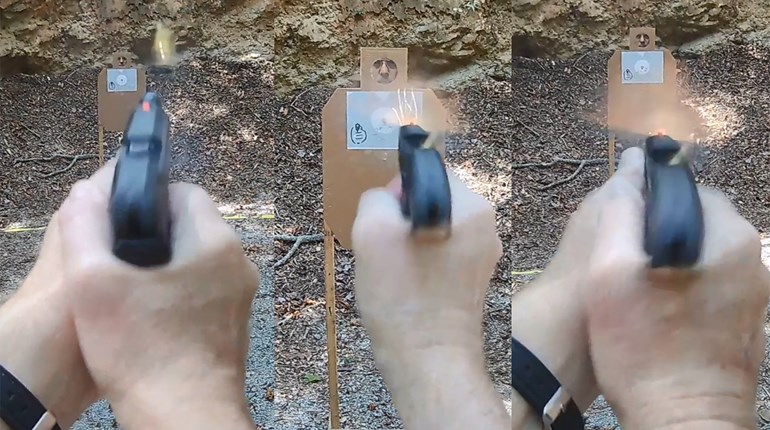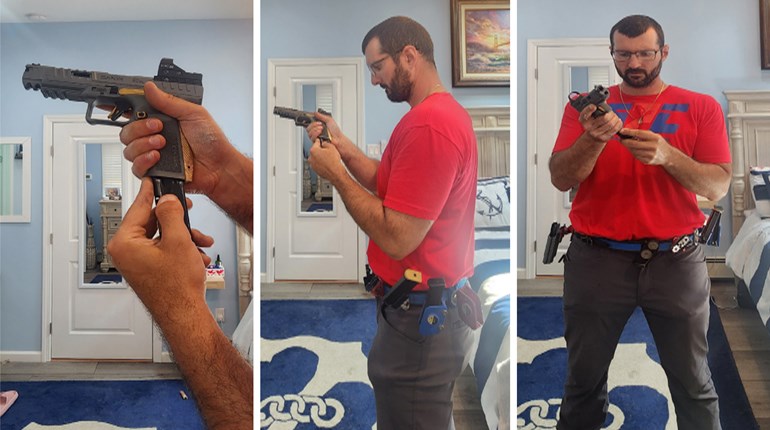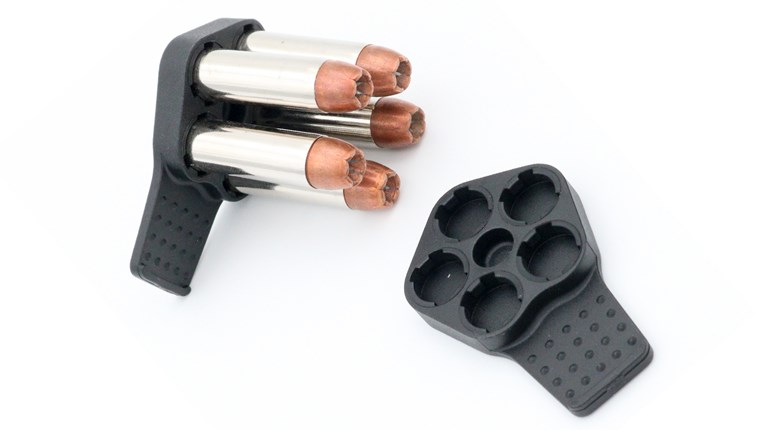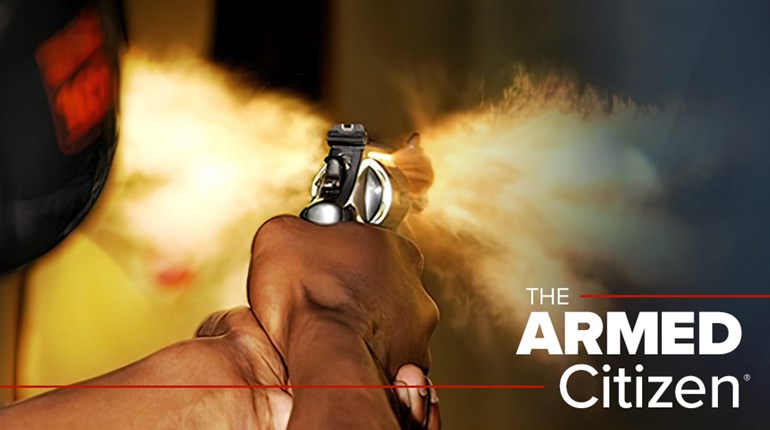
Without meaning to, we stirred the pot a little recently. Well, perhaps not the pot, but at least a pot—the pot of small pistol reloads.
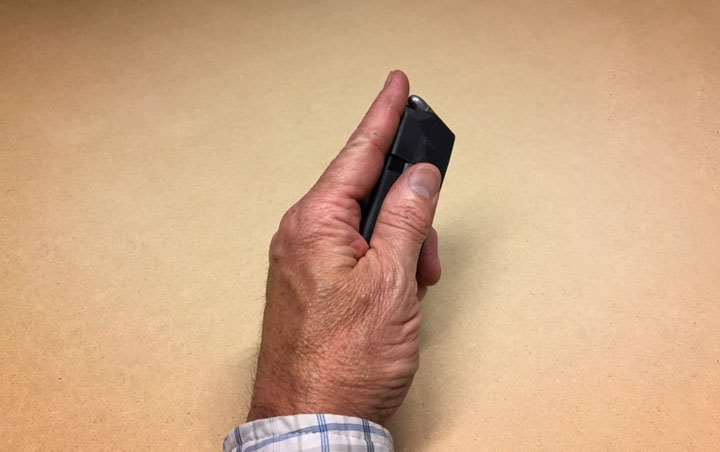
We’ve been up to our eyeballs lately in the smaller end of what we call carry-class firearms, what with a Glock 43/S&W M&P Shield shoot-off, and a very salient conversation with friend of A1F Daily, former Navy SEAL and defensive pistol impresario Jeff Gonzales.
The upshot is as follows: Given the demanding nature of shooting the small(er) handgun, particularly in a high-precision defensive role, what technique considerations emerge? Gonzales was compelling—as usual—and we’re in agreement (as we said here) with his postulation that marksmanship skills are harder to acquire as firearm dimensions decrease. This unhelpful reality is sometimes at odds with the day-to-day necessities of truly discreet carry. A small handgun may be your only option, and we took a look at specific shooting techniques here as a result. We doubt a reminder to actually practice them is called for; like almost anything else, repetition is the key to competence.
That practice, however, may well have exposed you to another conundrum of the small pistol: Their fit in even smallish adult hands seriously compromises speedy reloading. If your mitts are average or larger, the complexities and related fumbling may seriously compound.
There’s a rare happiness here for revolver fans: If that small firearm is a revolver, you’re the recipient of a major break. As long as there’s a speed loader out there for your model, the technique that works on Dirty Harry’s S&W 629 is only trivially different than that which works on, say, a 642. Bonus! Still, practice, practice, practice.
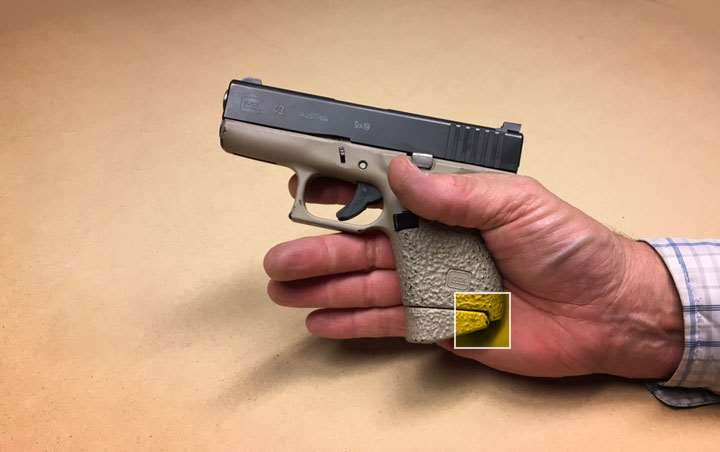
Semi-auto fans aren’t so fortunate. Those with largish paws don’t have to be anatomy wonks to quickly observe how los manos grandes actually make things tougher in the mag swap department. That grip-swallowing, recoil-reducing advantage at the end of your wrist with full-sized pistols is now too much of a good thing, and the single biggest benefit of magazine-fed firearms—the ability to expeditiously eject a spent or mostly spent ammunition source and replace it with a charged one—is at least impeded, if not altogether stopped.
This uniformly occurs at the fleshy base of the hand opposite the thumb, and is only exaggerated if you can actually reach the mag release without a grip shift—this closes the base of the hand even more. Your mag may well be released, but its fall away from the pistol’s grip is still halted. Grrrrrrrrr.
Believe it or not, you probably have the fix prefabbed; you just don’t know it.
<<Cue celestial chorus>>
If a “tactical” reload—often called a reload with retention—is part of your skill set, you’re about 90 percent of the way home. Unlike the ever-popular speed load (which allows the spent mag to fall and be immediately replaced), the “tac” reload retains the magazine and any rounds it contains. We refuse to get embroiled in the argument about which is better: Both decidedly have their place. If your tac reload knowledge is a tad rusty, take a look here for a very succinct synopsis of what is probably the most common type.
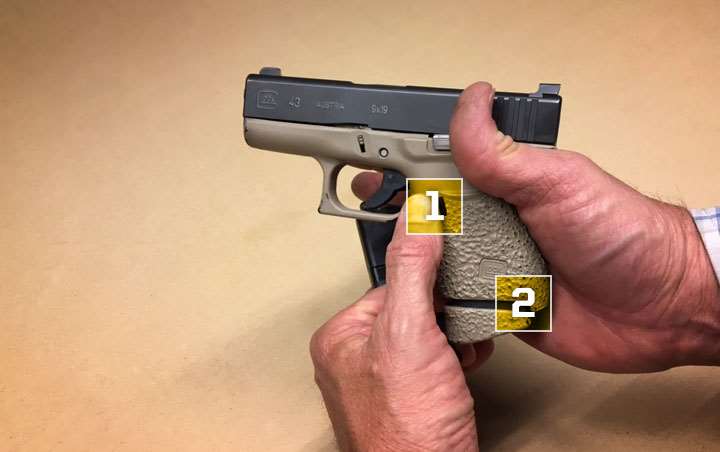
There are multiple versions of this “dual-threaded” technique, but the broad strokes are the same. The weak hand leaves the pistol to first retrieve a full magazine, then returns to the gun to “catch” the expended mag, replace it with the full one, and then stow the original magazine. The key is that both magazines are briefly in the hand at the same time, hence the “dual” terminology.
We’ve also seen serious arguments made that a single threaded method is actually better because it’s mechanically simpler: Remove the expended or partially expended mag and stow it, returning to the pistol with a charged magazine, and back to work.
With experienced practitioners, we’ve seen both of these—and their several variations—done with impressive speed. Like so many other things in shooting, there are many opinions about what is actually “best” in reloading with retention. For speed, we think double-threading is reliably faster, though it requires somewhat more work to get good at. Single-threading is commended by a simpler set of movements, but the stowing operation, if fumbled, puts delay in the process at the worst possible juncture—when you’re holding a single-shot, and when a recharge is still at the maximum possible distance (on your belt).
We’d assert that a reliable small gun reload does not permit as much variation. If you believe that the method should also be a transferable technique that works on many pistols of widely varying sizes—instead of a series of gun-by-gun variations—then the benefit is multiplied.
First, our method is dual-threaded. The weak hand leaves the pistol to retrieve the full magazine, while the strong hand draws the pistol back into what military and LE shooters call “the workspace.” If this is new terminology, think of it this way: It’s a roughly one-foot cube of space bounded at the top by your nose, and extending out for a foot from your chest at roughly shoulder width. Make sure the pistol stays in this volume during any reload; do not drop it down so you’re looking at the bottom of the magazine. Keeping it high lets gravity help as much as possible in getting an expended magazine to drop from the pistol. Depending on the size of your hand and firearm, you’ll also unwrap at least the two bottom fingers from the grip at this point. We partially unwrap the middle finger too, but this is highly personal, and not strictly necessary.
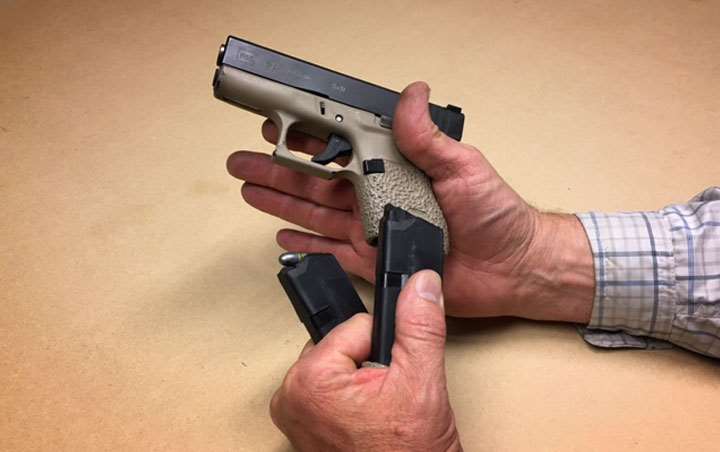
Note that you are not reaching for the magazine release with the strong hand thumb as you normally would—this job will get re-assigned in a moment. This is absolutely crucial to keeping the fleshy base of the hand from impeding the upcoming swap by rolling under the magazine you’re trying to remove from a short-gripped, smaller gun.
The weak hand, meanwhile, is approaching the bottom of the gun with that fresh, full magazine. The swap is dependent on a proper grip of the fresh mag as defined in many resources: The bullets are pointed forward, with the index finger aligned along the front of the magazine, and ideally with the tip of the finger even with the nose of the top bullet.
Just before the magazine gets to the gun—remember, both are now in “the workspace,” not rotated down near the belt—sweep or “swim” the index finger from the front to the left side of the magazine, and “open” the thumb (roughly toward your face). The new magazine is now held between the index and middle finger, and the hands are close to joining.
This is when the spent or partially spent magazine is released and removed from the pistol, though by left thumb actuation of the magazine release. It will fall partially clear, and can be withdrawn by closing the left thumb on the left side of the magazine, and against the left index finger.
Once the expended magazine is clear of the grip and magwell, pull the left hand toward you—about an inch and a half—and feed the loaded magazine into the magwell from between the index and middle fingers. “Follow” the magazine into the grip with the base of the left hand to seat the charged magazine.
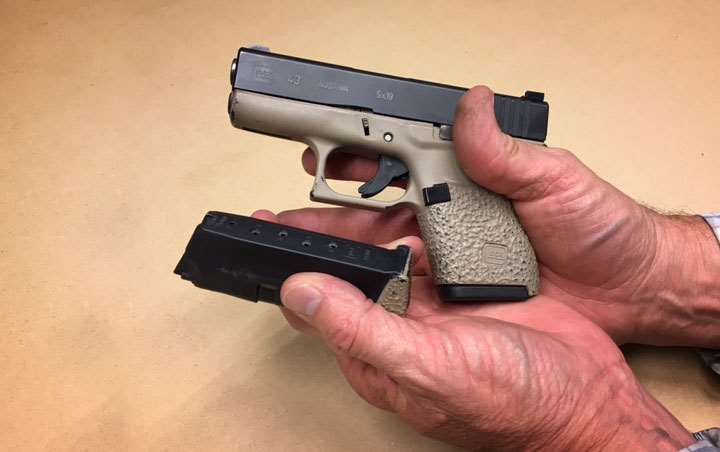
You now have a recharged small gun—where round count may really matter—and can shoot if you must with the strong hand.
We encounter three objections when we teach this, but they are usually answered with even a little practice. The first and most worrisome is the perception of an insecure grip on the pistol with the pinky, ring and part of the middle fingers off the gun during the transfer. This rarely survives the “dry” practice that should always precede a technique addition like this. When the motions run together—go for smooth, let speed come as a by-product—you’ll discover that both hands are actually on the gun at the crucial juncture. Certainly, it’s possible to jostle the firearm out of control, but this is true with many other manipulations (including the “flip” motion essential to many of us to reach the mag release even on a full-sized gun), and why we dry practice extensively, and first.
Second is the receipt position/fingers for the spent magazine. Some folks like to retain the more important mag—the full one—the most surely, that is with thumb and forefinger. We understand why, but remember that the thumb must be free for release actuation. Any other solution adds both time and movements—some of them quite convoluted—so we apply Occam’s Razor here.
Lastly, rely most on the strong hand thumb and forefinger to retain the pistol. Remember, that thumb grip has not been compromised by reaching for the magazine release, so its position is still strong against the index finger on the other side of the gun. If you try to use the middle finger too much, you run the risk of resisting the press of the mag release on the right side of the pistol, defeating the thumb pushing from the left. This is a highly individual issue, and more likely on some guns than on others. Practice solves this one easily, too.
There are a couple of benefits you might call “hidden” in this technique. People with small hands find it helpful on full-sized pistols because it’s so relatively powerful: Instead of straining to reach—much less press—the magazine release with the right thumb, they can apply left-thumb pressure with precision.
Finally, note that storage of that spent magazine is now on the very end of the process. It need have no impact on a post-reload shot, though you’ll want to practice strong hand only, right?
Now Carry on.











